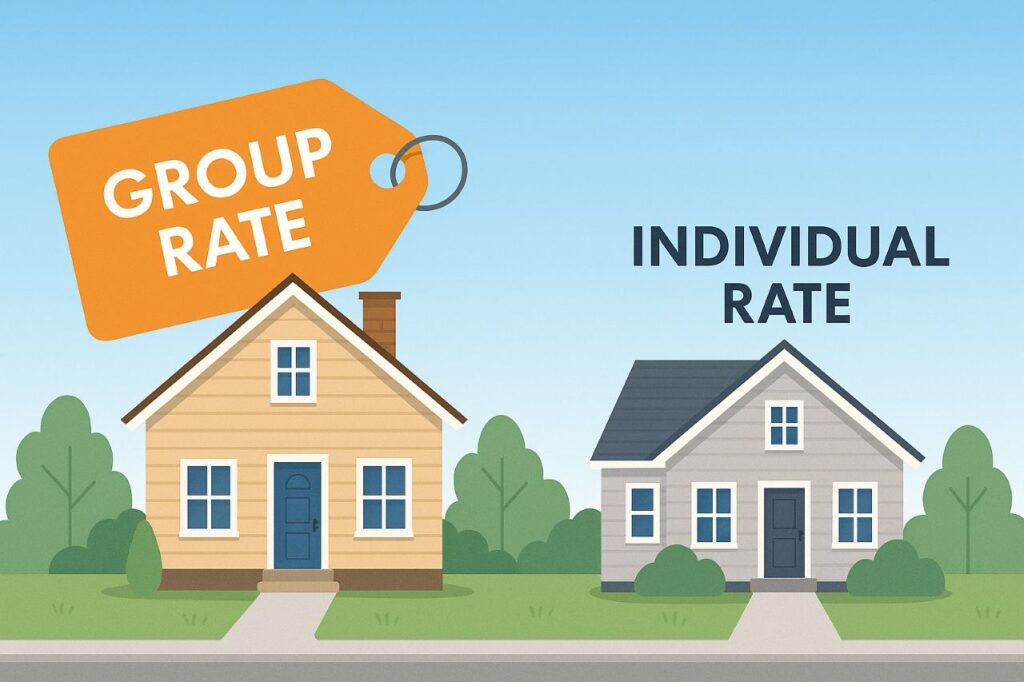Group Home Insurance Coverage: 5 Surprising Benefits
Group home insurance protection is quickly becoming an in-demand solution for individuals, families, and organizations that want thorough and economical protection for their home properties. Individual home insurance policies are different from group home insurance, where multiple homeowners or members of a given group (for instance, employees, condo owners, or association members) get to enjoy collective policy features, lower premiums, and extensive coverage options. With the increasing cost of living and growing risks related to natural disasters, theft, and liability claims, homeowners are turning to this innovative model to secure their investments.
In this guide, we’ll explore how group home insurance coverage works, its key advantages, real-life examples, and why it may be the right fit for you. If you’re a resident in a homeowners’ association, employer-sponsored policy, or co-living community, it’s imperative that you learn how this collective approach to insurance can make your wallet happier and your coverage broader in today’s uncertain world. From cost-sharing advantages to streamlined claims handling, let’s examine why group home insurance coverage is changing the property protection future.
Table of Contents
How Group Home Insurance Coverage Works

What is Group Home Insurance?
Group home insurance coverage is an insurance that covers several properties or individuals under one agreement. It’s most often sponsored by:
- Employers as employee benefits.
- Condo or homeowners’ associations (HOAs).
- Fraternal, professional, or alumni organizations.
- Housing cooperatives or group homes.
These policies provide discounted premiums because of the bulk aspect of the policy, and both insurers and members would find them attractive.
Key Features:
- One master policy for multiple homes.
- Uniform level of coverage for all parties insured.
- Reduced administrative expenses because of shared management.
- Streamlined renewals and claims handling.
Real-World Example:
In Canada, a number of institutions provide group home insurance coverage to alumni through affiliations with insurers such as TD Insurance. An example is the University of Calgary Alumni Association, which gives its alumni access to lower preferred rates and better protection options under the TD Insurance Meloche Monnex program. This partnership brings savings as well as added-value features to alumni across the country.
For additional details about group insurance options and benefits, you can visit resources such as TD Insurance’s group programs and Insureon’s group home insurance guide.
5 Surprising Benefits You Can’t Ignore

As home-ownership becomes more complex and costly, many are turning to alternative solutions like group home insurance coverage. This form of shared insurance offers more than just convenience — it brings unique financial, practical, and even psychological benefits that individual policies often can’t match. Here are seven powerful advantages that may surprise you.
1. Lower Premiums Through Bulk Buying
One of the greatest draws of group home insurance coverage is its ability to lower your premium considerably. Since insurers insure numerous policyholders at the same time, the risk is distributed over a greater number, and they can afford to give substantial discounts.
Why It Works:
- Insurers automatically apply volume discounts, usually without haggling.
- Administrative overhead is lowered through group underwriting, which means savings.
- Claims cost averaging through the group keeps premiums level.
Group insurance models can save homeowners as much as 10% to 30% compared to a plan for one, Forbes Advisor reports.
More Coverage Options — Typically at No Additional Cost
Most participants are not aware that group home insurance coverage generally includes extra coverage that are typically excluded from standard individual policies.
Typical Extra Coverage in Group Policies:
- Sewer backup and flood damage: Essential for participants living in areas prone to flooding.
- Cyber and identity theft protection: Necessary in today’s electronic age.
- Home equipment breakdown: Covers heating, ventilation, and air conditioning, water heaters, and kitchen appliances.
- Legal expense coverage: Help with real estate disputes or liability suits.
These package features give homeowners peace of mind and cut down on the necessity of buying expensive endorsements or add-ons.
Get a better understanding of these value-added protections at Travelers Insurance.
Tip: Ask your group carrier for a coverage comparison sheet so that you can compare how much you are benefiting.
2. Streamlined Enrollment, Renewal, and Administration:
Convenience that accompanies group home insurance coverage is a lifesaver — particularly for busy professionals, retirees, or group home administrators.
Benefits Include:
- No need to shop around and re-quote your insurance each year.
- Payroll-deducted premiums (frequent with employer-sponsored plans).
- Single-point claims handling through your organization or HOA.
Some carriers also provide group members with separate customer service phone lines to decrease wait times and enhance support quality.
Example: Companies such as NEA Member Benefits provide group insurance with simple online sign-up and member assistance.
3. Free Services That Enhance Property Value:
Most individuals assume insurance only pays out after it’s damaged — but group home insurance coverage typically involves proactive services that assist you in avoiding losses altogether.
Typical Free or Reduced-Cost Services:
- Home security assessments to help determine vulnerabilities.
- Digital or on-site appraisals to guarantee proper coverage.
- Plumbing, electrical, or roofing emergency service dispatchers.
By leveraging these services, you can reduce your risk — and maybe your premium in the long run.
Tip: Talk to your group provider about smart home discount programs (e.g., sensor or camera installations that lower your premium).
More and more insurers now align with technology companies like Ring and SimpliSafe to provide connected discounts on group policies.
4. Simpler Bundling With Other Types of Insurance
With group home coverage, it’s easier to bundle other insurance products such as auto, life, or renters insurance — and usually more beneficial.
Bundling Benefits:
- 25% discounts on all combined policies.
- Simplified billing — one bill covering all your coverage.
- Unified deductible options — just one deductible if a covered event happens to your home and car.
For instance, State Farm provides multi-line group packages with customized service and account management.
Go to State Farm Bundling Options to learn how bundling affects group coverage.
Who Should Look into Group Home Insurance Coverage?

Group home insurance coverage is no one-size-fits-all product — but it does provide customized advantages to a broad range of individuals depending on their housing circumstances, career affiliations, or age. From corporate employees of large firms to elderly citizens of assisted living communities, the group system is an elastic, efficient, and streamlined option compared to home insurance on an individual basis.
Here’s a closer examination of who profits most from this coverage:
1. Staff Members of Major Companies:
In the competitive working world today, employers are always seeking ways to enhance employee benefits and keep top workers. Providing group home insurance coverage is an affordable benefit that maximizes financial health for employees and shows support from the employer.
Why It Works for Employees:
- Negotiated group rates provide substantial yearly savings.
- Payroll deduction choices make it easy to pay.
- Premiums can remain constant even with small claims, due to risk sharing.
Staff who are covered under their group insurance plans with MetLife save as much as 25% on home and automobile premiums when purchased together.
Real-World Example:
Technology firms such as IBM and Dell have long-time relationships with carriers like MetLife and Liberty Mutual to provide group home insurance coverage as an optional benefit. Employees get to enjoy preferential rates for home insurance, complimentary policy reviews, and convenient claim support.
Explore more about IBM’s benefits with MetLife Voluntary Benefits.
Tip: If you work for a medium or large organization, see if your HR portal or employee handbook lists available group home insurance options.
2. Housing Cooperatives or HOA Members
Residents of co-ops, condominiums, or gated subdivisions can benefit greatly from group home insurance coverage provided by their Homeowners’ Association (HOA) or cooperative board. The shared facilities in these settings make it a must to have uniform insurance for sound risk management.
Advantages to HOA or Co-Op Members:
- Consistent protection throughout units means all are treated the same.
- Efficient catastrophe response, particularly after a fire, flood, or storm.
- Convenient liability coverage for common elements such as pools, fitness centers, or garages.
Nearly 30% of American homeowners reside in communities managed by an HOA, many of which implement master insurance policies to cover structures and common property, as reported by the Community Associations Institute (CAI).https://www.caionline.org/
How It Works
The HOA generally buys a master group home insurance policy that insures all buildings and common areas. Individual unit owners generally need to maintain supplemental coverage on personal property and interior unit improvements (“walls-in” coverage).
See Allstate’s Condo Insurance Guide for a complete explanation of how HOA coverage works in conjunction with individual policies.
3. Senior Citizens in Assisted Living
Seniors who live in group homes or assisted living facilities have special insurance requirements. Such residences often incorporate group home insurance as part of their service package, taking the responsibility of policy management away from residents while still providing peace of mind.
Why It’s Perfect for Seniors:
- No paperwork or payment worries to deal with.
- Furniture, liability, and minimum personal items are typically covered.
- Puts a stop to loopholes in coverage during crisis situations.
Facilities can include insurance as part of the rental or service contract, with fees incorporated in the monthly rate.
As reported by AARP, assisted living facilities often include group coverage for building structures, common spaces, and limited personal belongings.
Valuable Tip:
While group coverage through the facility may provide basic coverage, seniors must always inquire as to:
- Personal belongings (jewelry, electronics, mementos) are completely covered.
- Coverage for theft, water damage, or loss of power.
- A rider or supplemental policy is required for complete protection.
Tip: Seniors should investigate renter’s insurance riders or individual small policies to fill coverage gaps left uncovered under their group plan.
Read LTC News for information on insurance coverage for senior residents.
Other Groups Who May Consider Group Home Insurance Coverage

University Alumni:
Most universities collaborate with insurers to provide group home insurance coverage for alumni with competitive premiums and value-added services like legal advice and identity theft protection.
Example: The University of Toronto Alumni Association collaborates with TD Insurance to provide exclusive discounts on home insurance under TD Affinity Program.
Trade Union Members:
Electricians, plumbers, teachers, and nurses usually have access to insurance via their union memberships. Such group plans provide equal cover at less than market prices.
Research plans offered by organizations such as National Education Association (NEA) and American Federation of Teachers (AFT).
Group Homes for Disability Care or Special Needs:
Group homes for persons with disability usually carry group home insurance coverage arranged by the operating organization. This provides residents with protection without having to deal with individual policies, which is essential in susceptible populations.
Discover more about policy needs through National Council on Disability.
In conclusion, group home insurance coverage is perfect for:
- Corporate staff looking for affordable, trustworthy protection.
- HOA and co-op members requiring steady building and common area coverage.
- Seniors in assisted living looking for simplified, worry-free protection.
- Alumni, union members, and co-living residents who want tailored, discounted policies.
If you’re in one of these groups, now is the time to explore whether your organization offers this benefit — and take full advantage of this often-overlooked insurance option.
Group Home Insurance vs. Individual Policies

While both group and individual home insurance plans serve the same ultimate purpose — protecting your home and assets — there are several important distinctions in cost, customization, and administration. Choosing the right policy depends on your lifestyle, property type, and budget.
Cost Comparison
| Feature | Group Insurance | Individual Insurance |
|---|---|---|
| Premium Cost | Lower (due to bulk discounts) | Higher (based on personal risk profile) |
| Administrative Fees | Shared among members | Fully paid by individual policyholder |
| Flexibility | Limited to group-negotiated terms | Fully customizable based on individual needs |
Group home insurance coverage has the effect of lowering overall cost since insurers distribute the risk among several policyholders. This group leverage is possible, and discounted prices as well as lower administrative costs are achieved.
Policygenius reports that group insurance saves premiums by 10–30% over individual policies.
Tip: Even if your group premium appears lower, compare a stand-alone quote to ensure you’re not compromising on essential coverage options.
Customization Differences
While group home insurance coverage is convenient and cost-effective, it tends not to have the flexibility of individual policies. It still covers everything necessary, and many times it includes economical add-ons.
Differences:
- Group policies have more standard coverage than the minimum individual policy.
- You may often be able to purchase endorsements (e.g., identity theft, valuable article coverage) at a group discount rate.
- Lower deductibles and fewer exclusions are typical because of the pre-negotiated nature of the group contract.
Liberty Mutual provides optional riders on their group home insurance policies, such as smart home discounts and energy efficiency coverage.
Tip: If your house has unique features (such as a wine cellar or solar panels), talk to the insurer about custom riders or think about bundling group and supplemental coverage.
Limitations and Risks to Consider
Even with all the benefits of group home insurance coverage, it’s not always flawless. There are some limits and downsides that prospective policyholders need to know about before enrolling in a group plan.
- One-Size-Fits-All Coverage:
- Group insurance plans are made to cover a lot of people at once, which can lead to gaps for those with specific requirements.
- Common Limitations:
- May not provide individualized deductibles or coverage limits based on your property value
- Fixed liability limits that might not be appropriate for bigger estates or riskier locations
- Limited personal property coverage for things such as jewelry, collectibles, or artwork
The Zebra states that typical group home policies can be lacking in coverage for luxury items unless added to the policy as scheduled.
Tip: If you have unique or valuable items, always ask about scheduled personal property endorsements.
Exit or Membership Issues
One of the less-talked-about dangers of group home insurance protection is when you leave the group.
What You Need to Know:
- You may lose coverage if you change jobs, move out of an HOA, or quit an alumni group.
- New single coverage will likely be more expensive because of loss of group discounts.
- Your claims history won’t always transfer, so your insurance score with new companies could be impacted.
Consumer Reports advises checking whether your claims history is included in CLUE (Comprehensive Loss Underwriting Exchange) reports when changing insurers.
- Claims Impact:
- While the group model helps reduce costs, it also means shared consequences.
- Potential Downsides:
- A high volume of claims from other members can raise group premiums
- Insurers may apply blanket restrictions or exclusions if losses become frequent
- Policy non-renewal could occur if the group exceeds risk thresholds
Tip: Request your group’s claims history summary to assess the policy pool’s overall health.
How to Participate in a Group Home Insurance Plan

It is typically easy to get started with group home insurance coverage, particularly if you are a member of an organization that already provides this. Here’s how to gain access to these advantages based on your circumstances.
1. Through an Employer or Union:
Several companies and unions offer home insurance as part of optional benefit packages.
How to Enroll:
- Reach out to your benefits administrator or HR department.
- Sign up during open enrollment sessions.
- Enter minimal information (property size, home address, optional riders).
Check MetLife’s Voluntary Benefits Portal to see if your employer participates.
Tip: Find out if premiums are paid through payroll — it’s easy and avoids missed payments.
2. Through Professional or Alumni Associations
Alumni groups and professional associations usually work in collaboration with leading insurance companies to provide special access to group home insurance protection.
Typical Partners:
Illustration: TD Insurance provides specialized home and automobile insurance discounts to alumni of affiliated institutions.
HINT: Membership can be free or cheap — even joining in just for insurance access might be worth it.
3. Through Co-Ops or Shared Housing Arrangements
Group living arrangements, like cooperatives, retirement communities, or special-needs group homes, usually establish group insurance policies to facilitate compliance and make coverage easier.
What to Do:
- Reach out to the property manager or board of directors.
- Ask for a duplicate of the group policy.
- Request a personal certificate of insurance (COI) to document your personal level of coverage.
Most group homes that provide care for people with disabilities use group insurance to make financing and risk sharing easier, according to NCBI.
Tips for Maximizing Group Home Insurance Coverage

After signing up for a group home insurance coverage plan, there are several clever strategies to benefit even more from your policy.
- Bundle When Possible: Most insurers enable you to combine your life, auto, and home insurance into one policy, even under a group plan.
- Why Bundle:
- Additional savings of up to 25%.
- Streamlined billing and claims handling.
- Qualification for multi-policy loyalty discounts.
Bundling features from Progressive easily incorporate group discounts.
- Keep Records Current: Keeping your records and home inventory current assures prompt and accurate processing of claims.
- Best Practices: Have a digital or cloud-based inventory of valuable possessions.
Notify the insurer of renovations, new residents, or uses (such as a home business)
Use software such as Sortly for simple home inventory management.
- Fill in with Riders If Necessary: To tailor your group home insurance policy, add optional riders or endorsements, if necessary.
- Examples Are:
- Jewelry or fine art protection.
- Home business endorsements.
- Personal liability umbrella policies.
Discover riders at Allstate Insurance.
Tip: A yearly base rate charge for a rider may preserve thousands in the event of a claim.
Conclusion: Why Group Home Insurance Coverage Makes Sense

Group home insurance coverage is more than just a cost-saving strategy — it’s a smart, efficient, and increasingly popular way to protect your home and belongings. From bulk discounts and added perks to simplified management and broader protections, it offers real advantages to homeowners in associations, employment plans, or cooperative living arrangements.
However, it’s essential to understand its limitations and tailor the coverage to your needs where necessary. By comparing plans, adding optional riders, and staying proactive with documentation, you can ensure that your investment is well protected.
Take the next step today: check with your employer, HOA, or alumni association to see if you’re eligible for group home insurance coverage — and start saving while securing peace of mind.
Read Also: Home Insurance Pre Existing Conditions: 5 Risks to Avoid
Frequently Asked Questions (FAQs)
What is group home insurance coverage?
Group home insurance coverage refers to a policy that insures multiple properties or individuals under a single contract. It’s often sponsored by employers, homeowners’ associations (HOAs), alumni associations, or housing cooperatives. This collective approach allows for standardized coverage levels and often results in discounted premiums due to the bulk nature of the policy.
How does group home insurance differ from individual home insurance?
While individual home insurance is tailored to a single homeowner’s needs, group home insurance provides uniform coverage to all members of the group. This means:
1. Standardized Coverage: All members receive the same coverage terms.
2. Bulk Discounts: Premiums are often lower due to the collective bargaining power of the group.
3. Simplified Administration: Renewals and claims processes are streamlined for the group.
Who is eligible for group home insurance coverage?
Eligibility typically includes:
1. Employees of companies that offer group insurance benefits.
2. Members of HOAs or housing cooperatives.
3. Alumni of universities or colleges with partnered insurance programs.
4. Residents of group homes or assisted living facilities
What are the benefits of group home insurance coverage?
Key advantages include:
1. Cost Savings: Lower premiums due to group rates.
2. Enhanced Coverage: Access to additional protections not typically found in individual policies, such as identity theft protection or equipment breakdown coverage.
3. Simplified Processes: Easier enrollment, renewals, and claims handling.
Are there any drawbacks to group home insurance?
Potential limitations include:
1. Limited Customization: Policies may not cater to individual needs or unique property features.
2. Coverage Termination: Leaving the group (e.g., changing jobs or moving out of a community) may result in loss of coverage.
3. Shared Risk: High claims from other group members could impact overall premiums.
Can I customize my coverage within a group policy?
While group policies offer standardized coverage, some insurers allow members to add endorsements or riders for specific needs, such as:
1. High-Value Items: Additional coverage for jewelry, art, or collectibles.
2. Home Businesses: Protection for business equipment or liability.
3. Natural Disasters: Supplemental coverage for floods or earthquakes.
How do I enroll in a group home insurance plan?
Enrollment processes vary:
1. Through Employers: Contact your HR or benefits department.
2. Via Associations: Check the association’s website or contact their administrative office.
3. In Housing Communities: Speak with the property manager or HOA board.
What happens if I leave the group?
How can I maximize the benefits of my group home insurance?
To get the most out of your policy:
1. Review Coverage Details: Ensure it meets your personal needs.
2. Add Necessary Endorsements: For specific items or risks.
3. Maintain an Inventory: Keep records of your belongings.
4. Stay Informed: Regularly check for updates or changes in group policy terms.








One Comment